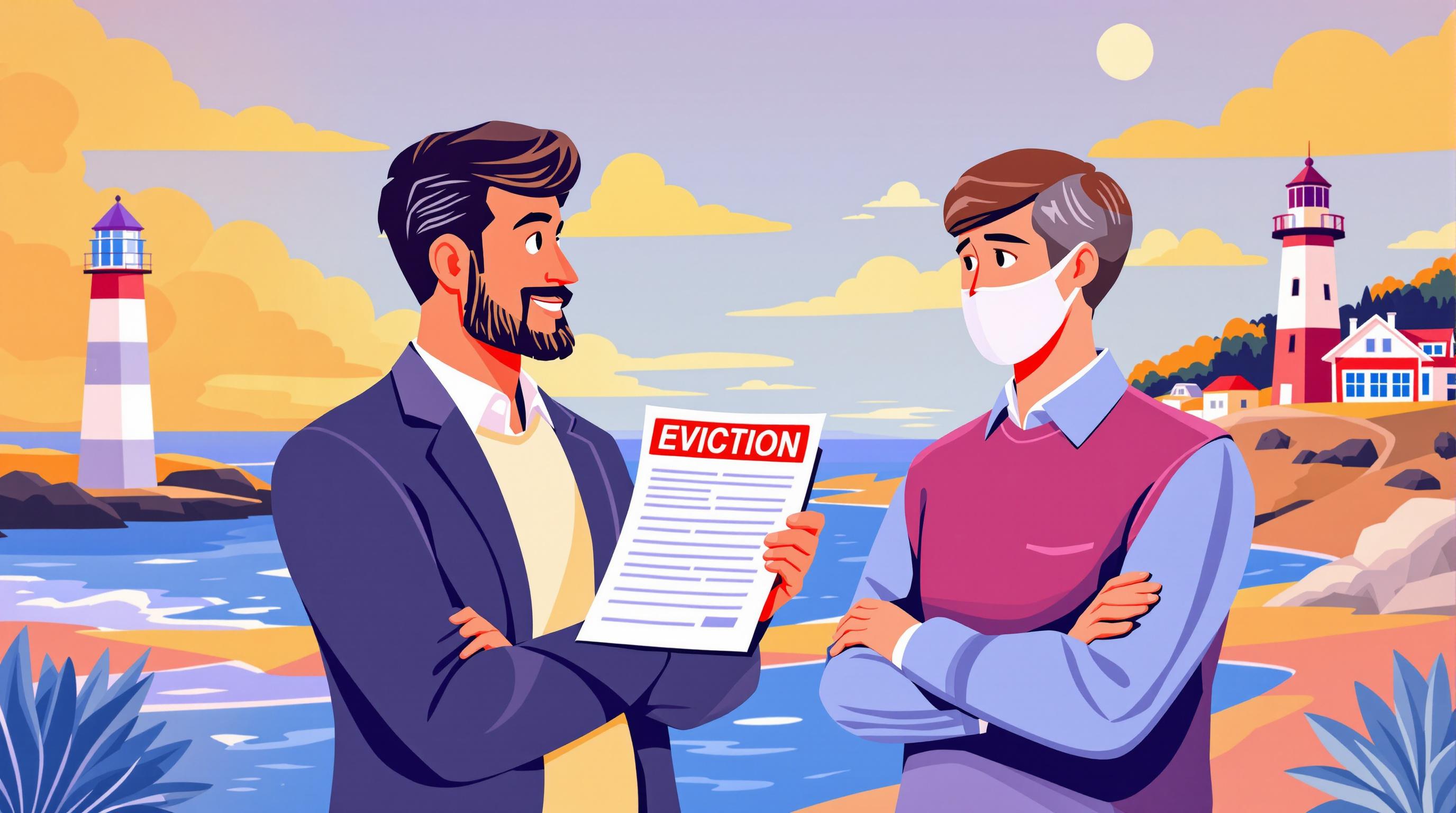Nova Scotia's rent control rules have been extended, capping annual rent increases at 5% until December 31, 2027. These regulations aim to balance tenant protections with landlord needs in a market experiencing rising rental costs. Here's a quick summary of what you need to know:
- Rent Cap: 5% annual increase for existing tenants; exemptions include new tenant leases and land-lease community lot fees.
- Notice Requirements: Minimum 4 months written notice for most rent increases.
- Exemptions: New tenant agreements, subsidized housing, and mobile home lot fees (capped at 5.8% for 2025).
- Profit Strategies: Upgrade properties with energy-efficient systems, leverage tax credits (up to $40,000 for retrofits), and explore government grants for repairs and accessibility improvements.
Halifax Market Alert: With a 1% vacancy rate and rental costs up 9.3% year-over-year, landlords should focus on maintaining compliance while optimizing income through smart upgrades and effective lease management.
Quick Tip: Leverage programs like the Secondary Suite Incentive Program (up to $25,000 forgivable loan) and the Home Repair and Accessibility Program (up to $34,000 in funding) to improve property value and attract tenants.
This guide provides actionable strategies to navigate rent control, maximize returns, and prepare for future policy changes.
Real Estate Investing in Nova Scotia: Rent Control, Market Growth & Nova Scotia Landlord Community
Nova Scotia Rent Control Rules 2024
Nova Scotia has updated its rent control guidelines, extending the 5% annual rent cap until December 31, 2027. These rules clarify how landlords can adjust rents and outline exemptions, providing a straightforward framework for both landlords and tenants. Here's what you need to know about the 2024 updates and how they might affect your rental plans.
5% Annual Rent Cap Rules Through 2027
The 5% annual rent cap applies to most residential rental properties. It covers lease renewals for existing tenants and new fixed-term leases for the same unit.
"Given the challenges we're facing in our rental market, we need to consider the increased costs that landlords face managing their properties. We need to balance this and extend the cap to help renters who are facing rising costs due to inflation" – Colton LeBlanc, Minister of Service Nova Scotia [2].
Notice Requirements for Rent Increases
The updated rules also require landlords to follow strict notification procedures for rent increases. The table below outlines the minimum notice periods and specific requirements for different lease types:
| Lease Type | Minimum Notice Period | Special Requirements |
|---|---|---|
| Standard Residential | 4 months written notice | Must specify the new rent amount and effective date |
| Weekly Leases | 8 weeks written notice | Same requirements as standard notice |
| Mobile Homes | 4 months written notice | Must use Form M specifically |
To ensure compliance, rent increase notices must include the new rental amount, the effective date, proof of delivery, and optionally, a brief explanation.
Exemptions to the Rent Cap
The 5% annual rent cap does not apply in certain cases, including:
- New tenant agreements
- Lot fees in land-lease communities
- Subsidized housing units
- Mobile home lot fee increases (capped at 5.8% for 2025) [3]
For subsidized housing, separate rules govern rent adjustments. Be sure to document exemptions carefully to avoid disputes.
Increasing Returns Under Rent Control
Even with a 5% rent cap, landlords can improve their returns by making smart upgrades and cutting costs.
Property Updates That Make a Difference
Strategic upgrades can justify competitive rents and keep tenants around longer. For example, companies like Helio Urban Development offer fixed-price, pre-designed units starting at $168 per square foot. These upgrades are not just about looks - they can also pave the way for savings through energy-efficient improvements.
Energy Upgrades to Save Money
Energy-efficient changes can lower your operating expenses and attract tenants who value affordability. Start with simple updates like programmable thermostats, LED lighting, and water-saving fixtures. For bigger savings, consider heat pumps (eligible for up to $2,000 in tax credits), solar panels (30% tax credit available [4]), or high-efficiency appliances.
Tax Credits and Rebates to Reduce Costs
Take advantage of tax incentives to offset the cost of these upgrades:
-
Home Repair and Accessibility Program
This program provides up to $18,000 for eligible repairs and $16,000 for accessibility upgrades, with contractors paid after satisfactory completion [6]. -
Canada Greener Homes Loan
Offers interest-free loans up to $40,000 for energy-efficient retrofits [7]. -
Energy Efficient Home Improvement Credit
Covers 30% of qualified expenses, up to $3,200 annually [5]. Includes $1,200 for energy-efficient improvements and $2,000 for heat pumps or water heaters.
For multi-unit properties, the IRS 45L credit offers up to $5,000 per unit for meeting Energy Star standards [8].
sbb-itb-16b8a48
Fixed-Term Leases and Rent Rules
Fixed-Term vs. Standard Lease Rules
Fixed-term leases operate differently from standard annual leases in Nova Scotia's rental market. Here's a quick comparison under rent control regulations:
| Feature | Standard Lease | Fixed-Term Lease |
|---|---|---|
| Duration | Automatically renews year-to-year | Ends on a set date, no automatic renewal |
| Notice Period | 3 months for both parties | May require up to 6 months' notice |
| Rent Cap | 5% annual cap applies | 5% cap only applies for the same tenant |
| Renewal | Automatic unless notice is given | Requires signing a new agreement |
| Rent Increases | Limited to 5% annually | No limits between different tenants |
These differences highlight the need for thoughtful lease management.
Best Practices for Lease Management
Understanding the nuances of lease types is key to managing properties effectively. Opinions on fixed-term leases vary. Property manager Jenna Ross mentions rising operational costs, while Ken Walker, an industry expert, cautions that prioritizing profits through fixed-term leases can harm tenant relationships. This divide shows the importance of finding a middle ground.
Guidelines for Managing Leases:
- Ensure lease terms comply with residential tenancy laws.
- Clearly communicate renewal terms to tenants.
- Keep thorough records of property conditions and agreements.
- Evaluate how lease decisions affect tenant relationships over time.
- Use fixed-term leases selectively, not as a default option.
Minister of Service Nova Scotia and Internal Services, Colton LeBlanc, explains the reasoning behind rent cap regulations:
"We chose five per cent to allow landlords to catch up to inflation, while avoiding any large rent increases for tenants" [10]
However, not everyone agrees. Margaret Anne McHugh, co-chair of ACORN's Dartmouth chapter, criticizes the system:
"Fixed-term leases have made Nova Scotia the eviction capital of Canada. The rent cap is meaningless as long as landlords can continue to get around any security of [rental] tenure with a fixed-term lease" [9]
Braedon Clark, housing critic for the Nova Scotia Liberals, adds:
"The fundamental problem is you can't have a rent cap system and fixed-term leases as they exist because they will continue to be used as a tool to circumvent the rent cap" [11]
Landlords should weigh the short-term financial advantages of fixed-term leases against the long-term goals of maintaining stable tenant relationships and sustainable property management.
Solving Rent Control Disputes
Resolving disputes effectively is crucial for maintaining compliance and protecting your investment. Rent control disputes often stem from three main issues:
Common Rent Control Disputes
- Rent Increase Compliance: Rent increases must strictly follow the 5% cap and be thoroughly documented [2].
- Payment and Eviction Timelines: Evictions can begin after three days of non-payment. Tenants have 10 days to either pay or contest [2].
- Tenancy Termination Reasons: Tenancies can be terminated for valid reasons, such as criminal activity, disruptive behavior, repeated late payments, or property damage [2].
Legal Help and Resolution Options
If disputes arise, there are several ways to address them:
- Direct Negotiation: Try to resolve disputes directly with the tenant. Keep detailed records of all communications and agreements.
- Residential Tenancies Program: File a Form J through Access Nova Scotia for a structured resolution process [15].
- Legal Support Services: Nova Scotia Legal Aid offers advice on residential tenancy laws [13].
Steps in the Dispute Resolution Process
- Document the issue thoroughly.
- Submit Form J via Access Nova Scotia.
- Participate in mediation or attend a hearing if required.
- Obtain the Director's Order and appeal if necessary [14].
The Residential Tenancies Program provides mediation and hearings to resolve disputes that can't be settled privately. This ensures issues are handled fairly while staying compliant with Nova Scotia's rent control laws.
What's Next for Nova Scotia Rent Control
Upcoming Policy Changes
Nova Scotia's rental market is undergoing changes. While the current 5% annual rent cap remains in place [2], new policies are on the horizon, including:
- Clearer rules for ending tenancies and updated subletting guidelines [2]
- Adjusted eviction timelines for unpaid rent [12]
- Mandatory inclusion of contact information in leases, with a 30-day update requirement [12]
The government is focused on increasing housing availability. As Minister Colton LeBlanc explained:
"We still strongly believe that the answer to the rental market challenges is more housing ... but in the meantime we have to protect Nova Scotians" [16]
New Support Programs
| Program Name | Benefit Amount | Purpose |
|---|---|---|
| Home Repair and Accessibility Program | Up to $18,000 for repairs; up to $16,000 for accessibility | Helps with property improvements for affordable housing [19] |
| Secondary and Backyard Suite Incentive Program | Up to $25,000 (forgivable loan) | Encourages creation of affordable secondary units [20] |
These updates emphasize the importance of revisiting your property management approach.
Planning Your Property Strategy
With Halifax's vacancy rate at just 1% [17] and the loss of 8,140 affordable units (<$1,000/month) between 2016 and 2021 [18], landlords face a challenging market. Adapting to the new tenancy rules is essential to staying profitable.
Key Strategic Considerations
-
Financial Planning
Halifax's 9.3% rent increase [17] reflects growing market pressure. Focus on controlling operating costs and planning for maintenance and upgrades while staying within the 5% cap. -
Leveraging Government Programs
Take advantage of grants for repairs and accessibility improvements. Consider developing secondary suites using forgivable loans. Keep an eye on new housing initiatives from the Department of Municipal Affairs and Housing [20]. -
Boosting Property Value
Minister LeBlanc noted:
Upgrades like energy-efficient systems, modern amenities, and accessibility features can help maintain and increase property value."Given the challenges we're facing in our rental market, we need to consider the increased costs that landlords face managing their properties. We need to balance this and extend the cap to help renters who are facing rising costs due to inflation" [2]
Staying informed about policy updates and utilizing available programs will help landlords navigate these regulatory changes while protecting their bottom line.
Conclusion: Quick Reference Guide
Rules and Profit Checklist
Here's a quick compliance and profitability guide to keep you on track:
Core Rent Control Rules:
- Maximum annual rent increase: Capped at 5% through December 31, 2027 [2].
- Mobile home rent increase: Limited to 5.8% [3].
- Service changes: Treated as rent increases [1].
- New tenant leases: Exempt from the rent cap [1].
Profit Optimization Strategies:
- Target ROI: Aim for 8–12% on residential rentals [21].
- Energy-efficient upgrades: Install items like LED lighting and smart thermostats [21].
- Tax deductions: Keep documentation for property improvements [21].
- Secondary suite development: Take advantage of government incentives offering up to $25,000 [20].
Rushi Parikh, a Commercial Mortgage Agent Level 2 at Clover Mortgage, emphasizes:
"Investing in rent-controlled real estate requires a broad plan of action, strategic asset selection, and proper understanding of regulatory nuances. Even within the restrictive environment, there is scope for opportunity for those investors who adapt effectively." [22]
Helpful Tools and Contacts
Make use of these resources to simplify your property management:
| Resource | Purpose | Contact Information |
|---|---|---|
| Residential Tenancies Program | Dispute resolution & regulations | Access Nova Scotia locations |
| Investment Property Owners Association of NS | Landlord support & advocacy | Member support |
| Legal Information Society of NS (LISNS) | Legal guidance | Free legal resources |
| Home Repair and Accessibility Program | Property improvement funding | Combined funding up to $34,000 [19] |
Key Government Programs:
- Secondary Suite Incentive Program: Offers forgivable loans up to $25,000 [20].
- Home Repair and Accessibility Program: Provides combined funding up to $34,000 [19].
Record-Keeping Tips
Stay organized by maintaining detailed records of:
- Tenant communications
- Property improvements
- Maintenance schedules
- Operating expenses
- Email contact information [2]
Related Blog Posts
- 7 Ways to Maximize Rental Income with Multi-Unit Properties in Nova Scotia
- The 5 Biggest Mistakes Investors Make Building in Nova Scotia - And How to Avoid Them
- Vacation Rental Laws in Halifax, Nova Scotia: Short-Term vs. Long-Term Investment Prospects
- Understanding Cap Rates in Halifax, HRM, Nova Scotia: Key Influences and Real-World Examples



